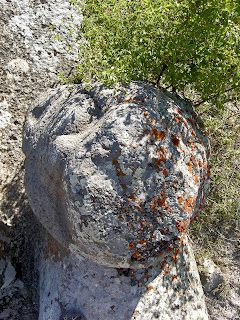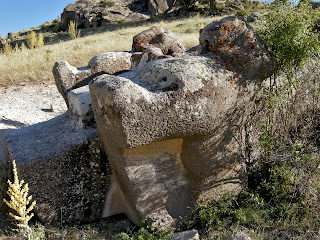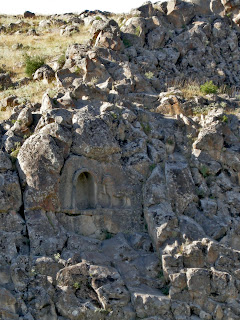Photos by Jack A. Waldron
After leaving the sacred Hittite spring at Eflatun Pinar, I cycled west to Beysehir Golu (pictured above and below). Some years later I would cycle the opposite bank of the lake, which has some special hidden and virtually unexplored ancient sites. However, my next destination on this day was Fasillar, or ancient Mysthia (37°39'29.3"N 31°53'49.7"E), as it was later known to the Romans.
Along the way I came across a restored Osmanli era bridge, the Tarihi Bada Bridge. Though now only a walking bridge, its restored condition would certainly tolerate heavy loads.
I imagine there must have been a Roman bridge somewhere near, or perhaps the Osmanli bridge was built in its place, on its footings?
As you can see in these photos, the modern crossing loops around the ancient bridge offering a full view of the structure.
Interesting in design, the leeward side of the bridge of course does not have protruding pylon feet to split the current as it hits the bridge, whereas the water-ward side of the bridge does (pictured above and below).
Pictured below is the water-ward side of the bridge, which has protruding feet that ease the impact of the river flow.
My cycle through the back countryside roads was truly relaxing, and I must accept that cycling is so much more relaxing than sailing. There is no rush to arrive, no wind or swell to concern yourself with, and I could even stop at a small corner market in Cicekler for an ice cream, a cola, and a chat with a wonderful small village shop owner to share some humanity.
After leaving Cicekler, it wasn't long before I happened across a narrow dirt path off the left side of the road that wound up and around the mountain (pictured below, left to right).
Though you cannot really make it out, the Fasillar Hittite monument is situated on the slope in the right side of the photo above. Pictured below, a closer view of the monument/stele/obelisk in situ (pictured bottom center).
As explained below, some believe this Hattusili III period monument/stele was intended to be erected at the sacred spring of Eflatun Pinar, though this can hardly be known for certain, and further, I have a new hypothesis that I will go into detail about further down in this post.
The map below is on display at the Museum of Anatolian Civilizations in Ankara next to a full size reproduction of the antiquity, and shows the location of the monument on the map within Türkiye.
Pictured below, I am standing next to the reproduction. I am not sure of the weight of the reproduction, but it is estimated that the monument/stele/obelisk in situ weighs approximately 70 tons, with a height of approximately 8 meters, and a width of about 2.75 meters.
The god figure in the center has two lions situated at either side of his feet. This imagery appears to be an obvious precursor to the Anatolian goddess Kybele, who is also represented situated between two lions, the imagery of which I will go into greater detail further down.
Visitors to the museum are also shown a placard with a photo of the original monument in situ (pictured above). Pictured below, a close up of the reproduction.
The Storm God is flanked by two lions, having his right foot on the shoulder of the lion on that side, while his left foot is situated atop the head of the Mountain God. Pictured below, a shot of the original monument in situ, uncovered, unprotected, without guard or further care.
When I arrive at such a site as Fasillar, I don't change my riding clothes, or my shoes (because I have cleated cycle sandals!), and I keep my helmet on for protection from the intense Anatolian sun.
Pictured below, a shot of Fasillar Village with the Fasillar monument/stele/obelisk in the foreground, which is called Kurtbesigi by the locals. Further up the slope under a massive shade tree is where I camped among the ancients for the night, in pure silence.
This monument is amongst some of the largest ancient sculptures known, and is made from basalt rock. It is very difficult to get a good photograph of the complete sculpture, which is why I've included the replica sculpture erected outside the front door of the Anatolian Civilizations Museum in Ankara.
Pictured below, the head of one of the pair of lions (right) that are positioned at either side of the standing Storm God.
In these photos (above and below), the lion's muzzle is pointed up to the right, with its ears turned back at bottom left.
Pictured below, we see the same lion (right) viewed from directly in front of its muzzle.
Pictured here are the faces of the two lions up close (above and below). They are meant to warn, to be avoided, and represent danger. However, they live in harmony with the wilderness, as most humans once did.
It's been estimated that the Fasillar Monument sculpture was undertaken during the 13C BC, and as was mentioned above, intended to be a dedicatory member amongst the Eflatun Pinar sculptures at the sacred spring of the same name, though I have my doubts.
Pictured above you can see both lions situated at the bottom of the monument, the front leg of the lion on the left of the sculpture, and the full body of the lion on the right of the sculpture. Also notice, the rectangular rock protrusion from the bottom of the sculpture, which is obviously meant to be the fixed anchor for the monument, which I will speak more about further down.
Pictured above and below, a Mountain God stands with his hands clinched together between the two lions. I cannot express enough the similarities between this representation and the Phrygian representations of Kybele.
Kybele was the connection and barrier between nature (lions) and the civilized world (human society). She protected communal life from the hazards of nature, wilderness, and savagery.
These lions are the representations of the wild, the dangerous, to be avoided, killed, or tamed. There is a message here, of living in harmony with nature, while at the same time respecting its right to Be.
Pictured above, a close-up of the Storm God, with four rectangular protrusions from his head piece, that are meant to represent horns, which again reinforces a connection with the wilds of nature.
I imagine the Storm God holding a massive thunderbolt in his right hand, ready to strike those who are careless with regard to nature. He is warning of an event that will come, and is unapologetic to those who ignore his power.
Some claim that the Fasillar Monument was ordered to be built by the Hittite King Muvattali after the Battle of Kadesh (1243BC), fought between the Hittites and the Egyptian Pharaoh Ramses II in order to give their spin on the event and the treaty that followed. I have not seen any evidence to support this.
Sorry for not getting a complete photo, but without a ladder, a selfie stick, or a drone, it is impossible to take a photo of the complete face of the sculpture in situ. So, I put the camera on 10 second photo delay mode, stretched my arms as high as I could over the monument, and hoped for the best (pictured below).
It's not every community within Turkey that can boast to have on display such a monumental Hittite sculpture. This truly is something very special, and I hope the village is on guard and protective of this ancient gem.
In the photo above, it was under the massive shade tree at the top center of the hill where I camped for the night. To the right of the shade tree is a long high ridge, on the face of which can be found some spectacular tomb reliefs, which I will write about further on in this post.
A complete shot of the ridge can be seen in the photo below. I originally had planned Photo-Shopping these photos into a panoramic image (since my archaic camera lacks the ability), however, with teaching and sailing keeping me very busy during the summer of 2024, I just don't have the time. Yes, I am three years behind in my posts. Remember, I did not cycle during the pandemic.
I did explore the top of the ridge, but I couldn't find any signs of antiquities. That said, opposite the ridge further up the slope from the Fasillar Monument is an ancient underground cistern (pictured below, right side of the photo).
In this photo (above), there is a water tank parked next to the cistern, which I suspect was used to supplement the cistern. Obviously, the black hose from the water tank is used to fill this rock honed basin, but what I find very interesting is that the inside of the hollowed out basin is the same size as the protruding rock nub at the bottom of the Fasillar Monument (pictured below). I'll return to this topic further down.
Also, there were several large water tins outside the cistern entrance (pictured above). I think this shows that this is still a valuable water source for the community several thousand years after it was discovered and tapped.
It's such a unique opportunity to be able to explore such a water source, especially such an ancient cistern that is still productive and utilized. Another location where I found very similarly designed underground cisterns was in ancient Kilistra, just 25 kilometers to the east of Fasillar (which I will be writing about soon). So, down into the depths I went.
As you can see in the photo below, the water level rises and falls with the changes of season, but water there was, and is. In my opinion, this perennial water source is what made this location so important for the Hittites, the Persians, the Greeks, the Romans, and so on, and is the main reason the ancient north/south road came through this site.
Further, with what we know about the Hittites and the importance they placed upon respecting, showing dedication to, and worshiping such water sources, I have a new hypothesis with regard to the Fasillar Monument, that I will go into more detail about here.
This monument was not destined to become a facet or fixture of the Eflatun Sacred Spring some 35 kilometers to the northwest of Fasillar, but was instead intended as a dedicatory sculpture meant to be erected at this site, the Sacred Spring of Mysthia, or Fasillar, or what ever the Hittites called this place. It may even have been planned to be fixed atop the hollowed out basin honed into the rock near the entrance to the cistern (where the black hose sitting).
Pictured above is a very rough Photoshop image of a re-imagined dedicatory sacred spring monument, though I didn't have the correct photographic angle to fit the monument into the hollowed out basin. So instead, I put the monument directly over the entrance to the spring. The basin may have been intended as the female base to the male protrusion at the bottom of the Fassilar Monument. Pictured below, the rectangular rock protrusion at the bottom of the monument can be seen.
Furthermore, the large rounded/squared boulder sitting to the right of the hollowed out basin/base (pictured two photos above) may have been intended to sit under the lions (assuming there were a pair of these boulders), and might have been sculpted into Forest Gods, Water Gods, or one of each, similar to those situated at the bottom of the Eflatun Pinar Sacred Spring dedicatory sculpture.
Turning back to the ridge opposite the ancient cistern and Fasillar Monument, there are two dedicatory reliefs dating from a much later period, possibly from the Hellenistic period, or an earlier Greek period, and another believed to be from the Roman Imperial period. The first is pictured above and below, high up on the rock face.
The second relief (pictured below), is situated on a rock face outcrop further to right of the first relief, though from this distance its brilliance has yet to be shown. However, you may be able to see the image of a horse at the center of the photo.
Climbing up to the first relief (pictured below), I could not find an inscription on or near it, however there may have once been such an inscription, but it appears that the top of the monument has been broken off and is missing.
I am inclined to identify this monument as a dedicatory stele for an honorable soldier or citizen. There appears to be a small relief to the right of the monument, which to me resembles a soldier with shield.
Looking at the photo below, which was taken from just in front of the first dedicatory stele, we see the red tile roofs of the village houses at the bottom of the slope, but I also imagine the ancient road leaving the village, which is the crooked white trail leading away into the distance.
The rocky outcrop at the top left of the photo above is the location of the second dedicatory relief, and this one does have an inscription, in Greek, and it tells us exactly who the dedication is for.
You can see both the dedicatory relief and the inscription in the photos above and below. But truly, it is necessary to climb all the way up the rock face in order to appreciate the quality of the relief.
The Greek inscription tells us that a young man named Lucien or Lucianus is being commemorated for his horsemanship, and that he died at young age, perhaps as a soldier? I think it is quite possible that Lucien/Lucianus was a young soldier who was held in high regard and honor by those he served with. This is certainly reflected in the exquisitely fine sculpted relief that has been produced for him.
I've included two different photos of the relief inscription for those interested in doing a translation, and I hope the two different angles help to see it clearly.
The relief is known as Atlikaya, or 'the Rock of the Horse', or 'Rock of the Horseman', and it is believed to be a Greek relief based on the dedicatory inscription (pictured above), and the inscription directly under the monument (pictured further down). I have some thoughts on this monument, which I will delve into further down.
Continuing higher up on the rock face we find a finely sculpted relief of a majestic horse pounding its right hoof into the ground as it peers into the arched dual columned tomb belonging to Lucien/Lucianus, who I suspect was a young calvary soldier of a high ranking family.
I cannot express enough my surprise with regard to the quality of this relief. What I mean is, Mysthia was an important water hub along the north/south/east roads connecting ancient Isaura to the south (located atop a high mountain surrounded by the villages of Hicilar, Isiklar and Yazdami), ancient Antiocheia Pisidiae (Yalvac) to the northwest, ancient Iconium (Konya) to the northeast, and ancient Lystra to the east: however, to have commissioned such a quality sculptural work at this remote location must have set a precedent.
The bridled horse is magnificent, and simply a majestic sculpture of strength and quality that has rarely been rivaled in my travels. The horse is decorated with what appears to be a partially braided mane supporting both an ornamental neck piece and breast piece, a sheepskin back pad, while presenting an unrivaled honorable stature: this is truly a reflection of the young Lucien/Lucianus. This is a masterpiece, and was certainly a very expensive commission. But, who was Lucien/Lucianus?
It is believed that this monument dates to the Roman Imperial period, and it may, but how difficult would it have been to find such a master sculpture in Mysthia, or the surrounding area? Mysthia was a central hub or crossroads, so there must have been master artisans/sculptors passing through. Notice the Greek inscription directly under the relief.
Might a Roman legion have been passing through when young Lucien/Lucianus lost his life unexpectedly? Along with the legion/s there would have been accompanying members, such as craftsmen, artisans, and so on, and perhaps there was a master sculptor in the train? We may never know.
*All photos and content property of Jack A. Waldron (photos may not be used without written permission)
**Please support my work and future postings through PATREON:
Or, make a Donation through PayPal:


























































